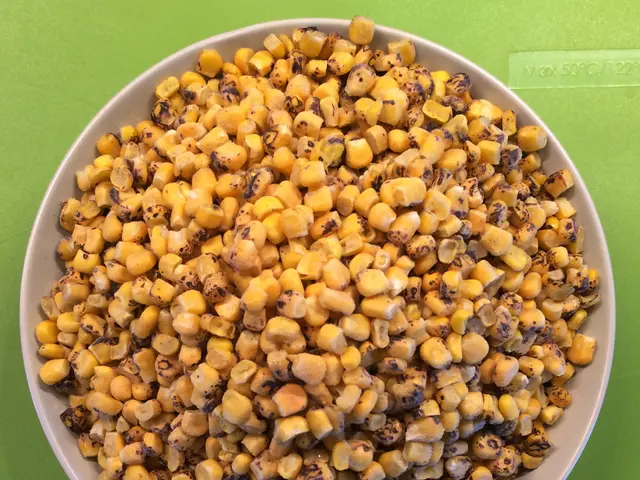Guide for Self-Made Natto Production at Home
Making Your Own Natto at Home!
Say goodbye to store-bought natto with this simple guide to making your own delicious, nutrient-packed homemade natto!
What is Natto?
Natto is a classic Japanese dish formed from soybeans that undergo fermentation by Bacillus subtilis bacteria. The fermentation process gives the soybeans a distinct taste, aroma, and texture. It's often compared to melted cheese due to its stringy consistency.
But what does natto taste like? It offers a subtle rich flavor with umami undertones that thrills taste buds and leaves many hooked. However, some may find its unique aroma and acquired taste off-putting.
Love it or hate it – natto is an addictive delight for enthusiasts. Customarily eaten for breakfast, mix it with hot rice, add a splash of soy sauce, and top it off with mustard, creating a nutritious meal packed with benefits.
Natto's Health Benefits
Homemade natto boasts numerous health advantages. Primarily, it contains high levels of vitamin K2, essential for heart and bone health (ref.). Besides, the fermentation process makes soybeans easier to digest and eliminates their anti-nutrients (ref.). This means you can enjoy all the benefits of soy without the potential drawbacks.
Additionally, natto supports a healthy gut microbiota. It contains billions of probiotic bacteria, as well as prebiotic compounds, which nurture and fortify our gut microbiota (ref.). A well-maintained gut microbiota plays a crucial role in our immune system and cholesterol regulation.
Discover more about the healthy effects of natto in our detailed article - The Science-Backed Health Benefits of Natto.
Gather Your Ingredients for Natto Production
Prepare yourself for the natto-making adventure, as you'll only need two components: soybeans and natto culture.
Whole Dried Soybeans or Specialized Soybeans
Use authentic whole dried soybeans, which you can purchase from health food stores or in bulk. For beginners, you can also find soybeans specifically designated for natto production, creating milder and more accessible natto.
Natto Culture
Natto culture harbors B. subtilis bacteria and is necessary to inoculate soybeans to start the fermentation process. Purchase natto culture online or use an already fermented batch as a starter culture (backslopping).
Get Your Equipment Ready for making Natto
Producing natto requires minimal gear. Most required gear can be found in any household kitchen, with one notable exception: maintaining a consistent temperature during fermentation.
Kitchen Essentials for Making Natto
- Large saucepan
- Spoon for stirring
- Kettle
- Glass or stainless steel container
- Cloth (dishcloth or similar)
- Aluminum foil or plastic wrap
- Cooking thermometer (optional but handy!)
- Incubator
Ensure all equipment is exceptionally clean! Use a dishwasher if available or sanitize all gear with a food-grade cleaner like Star San. For more information, read A Comprehensive Guide on Cleaning and Sanitizing Fermentation Equipment.
Incubator Options for Natto Fermentation
The key to successfully fermenting natto is ensuring the beans remain warm during the process. Maintain the temperature between 37°C and 45°C (99°F - 113°F). Several incubator options are available:
- Instant Pot-style pressure cookers
- Yogurt makers
- Dehydrators
- Cooler filled with hot water bottles
- Oven with the light on
Whatever your incubation strategy and tools, aim to preserve the incubation temperature between 37°C and 45°C. Monitor the incubator temperature by inserting a thermometer into the soybeans to adjust as needed.
Method to Prepare Natto Like a Pro
Preparing Soybeans for Cooking
To cook soybeans efficiently, start by soaking them for at least 6 hours (ideally overnight). Then rinse them thoroughly. Cook via either the boiling water method or pressure cooker, aiming for tender beans, which can be crushed with your fingers.
Sanitizing Your Equipment
Sanitize your tools for a germ-free natto-making process! We recommend using a dishwasher or a food-grade sanitizer like Star San.
Inoculating Cooked Beans with Natto Culture
Activate your natto culture by immersing it in boiling water. The water mixture will then be combined with the cooked beans.
Incubating and Fermenting Soybeans
Incubation triggers the growth of microorganisms. Continue fermentation for approximately 12 to 24 hours, maintaining a warm and moist environment during the process.
Refrigerate Natto for Consumption
Once fermentation is complete, refrigerate the natto to slow down the process and extend its shelf life for up to a week.
Delicious Homemade Natto Recipe
Yield: 2 cups
Preparation Time: 12 to 24 hours
Ingredients
- 4 cups soybeans
- 1/2 tsp Natto starter culture
Steps
Preparing Soybeans
- Rinse and soak the beans overnight.
- Rinse again and cook in a large saucepan until tender (approximately 4 hours). Alternatively, use a pressure cooker and cook for 45 minutes. The beans should be soft enough to be crushed with your fingers.
Sanitize Your Equipment
- Sanitize all gear by washing, rinsing, and soaking (for at least 2 minutes) in a gallon of water with Star San or an alternative sanitizer.
Adding the Culture
- Bring water to boil in a kettle. Transfer 1/2 cup of hot water to a small bowl and let it cool for 5 minutes.
- Add 1/2 tsp of natto culture powder to the water and mix well.
- Once the soybeans have cooled slightly, add the water and natto culture mixture, ensuring the culture is evenly distributed.
Fermentation and Incubation
- Preheat your incubator to 40°C (104°F).
- Transfer the inoculated soybeans to small containers, leaving about 1 to 2 cm of space.
- Cover containers with cloth and seal with plastic film.
- Place the containers inside the incubator and allow them to ferment for 12 to 24 hours.
Enjoy your creamy, savory homemade natto over rice or with a side dish of your choice! Don't forget to stir the natto to activate its stringy texture.
Tips for Storing Natto
- Refrigerate natto for a week when stored properly.
- Portion natto into individual containers and freeze for convenient daily use. Remove the container from the refrigerator the day before consumption.
How to Eat Natto
Traditionally served for breakfast, mix your natto with chopsticks to activate the silky texture. Try it over rice with:
- Soy sauce
- Mustard
- Sliced green onions
- Fried eggs
- Homemade kimchi
- Spicy chili oil
- Sesame oil
Enjoy your delightful meal!
Expand Your Fermentation Journey
- Purchase natto culture
- Read The Science-Backed Health Benefits of Natto
- Learn how to make miso and tempeh
- Explore the book "Miso, Tempeh, Natto"
- Buy koji, tempeh, natto, sourdough, and fermentation starter kit
Get started on your natto adventure today!
- Natto, a traditional Japanese dish, is created by fermenting soybeans with Bacillus subtilis bacteria, resulting in a distinctive flavor, aroma, and texture compared to store-bought natto.
- The health benefits of homemade natto are significant due to its high vitamin K2 content, making it beneficial for heart and bone health, and the elimination of anti-nutrients during the fermentation process, allowing for all the benefits of soy consumption without potential drawbacks.
- The process of making natto at home involves only two components: soybeans and natto culture; Kitchen essentials for making natto mainly consist of a large saucepan, kettle, glass or stainless steel container, and an incubator, with cleaning being crucial to the natto-making process.
- Natto supports a healthy gut microbiota as it contains billions of probiotic bacteria and prebiotic compounds, contributing to immune health and cholesterol regulation.








